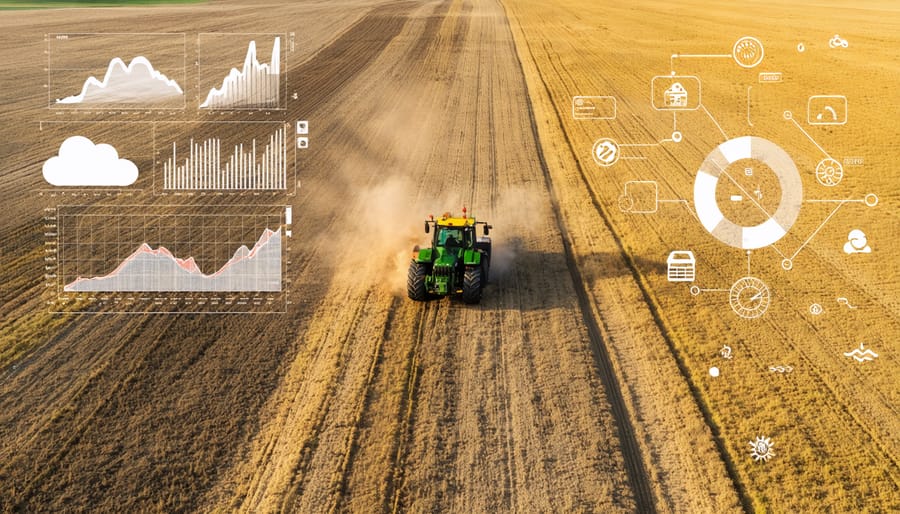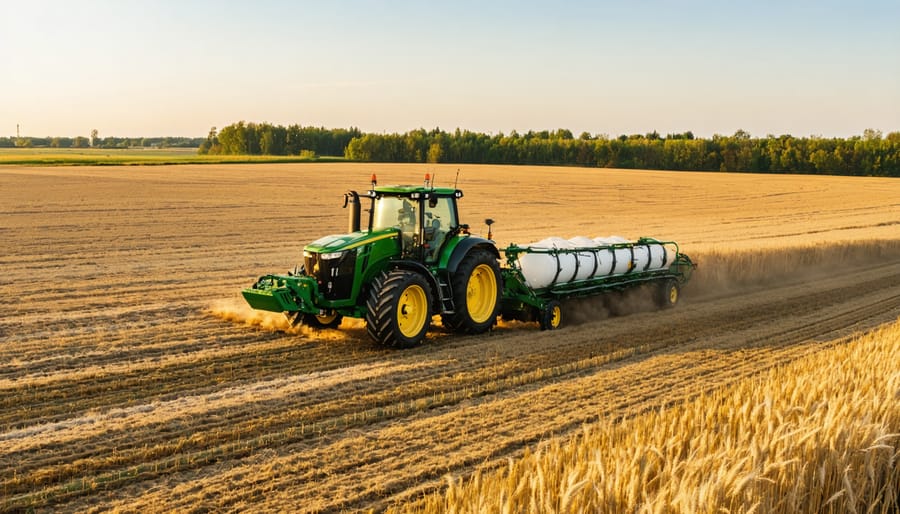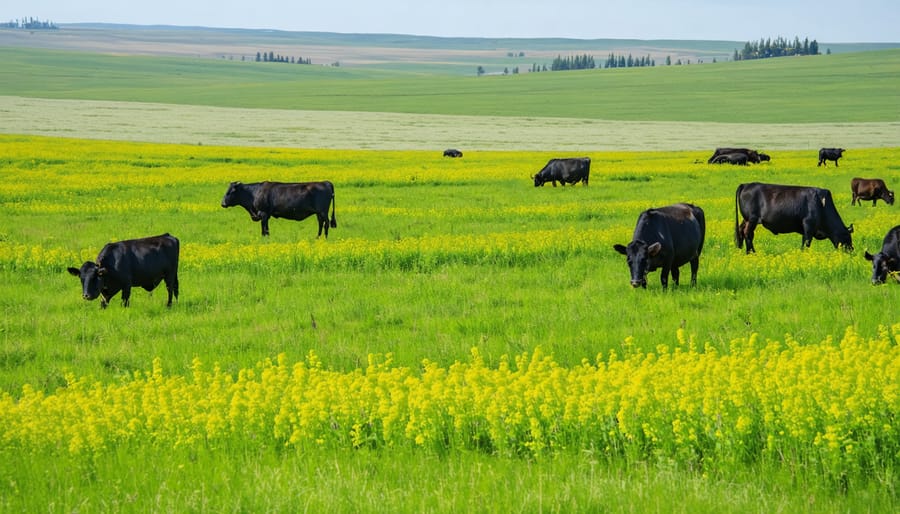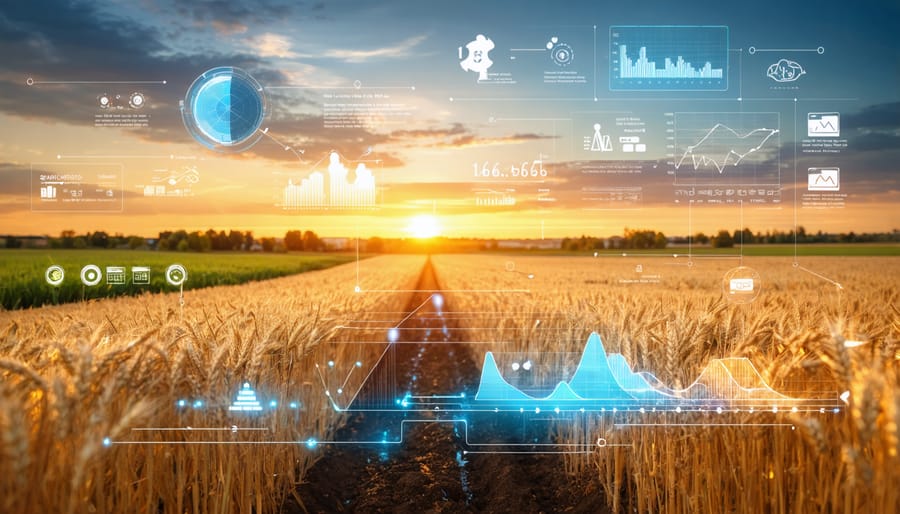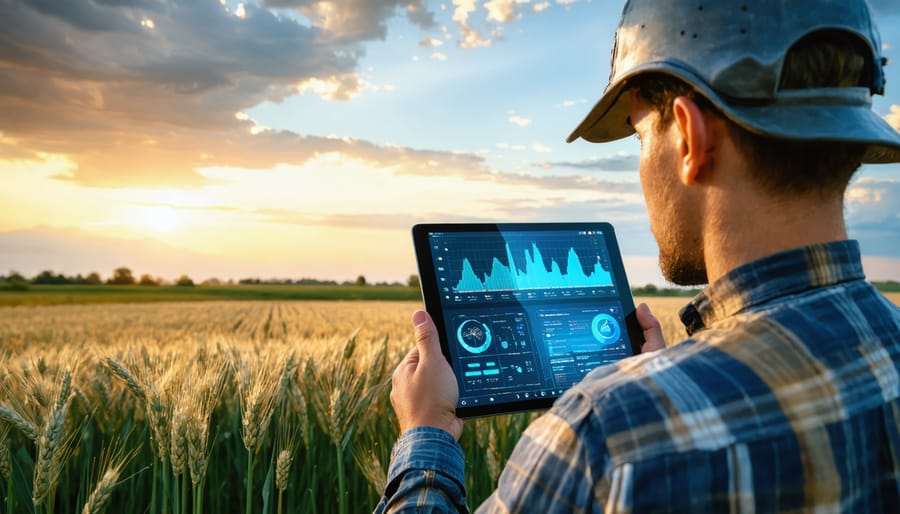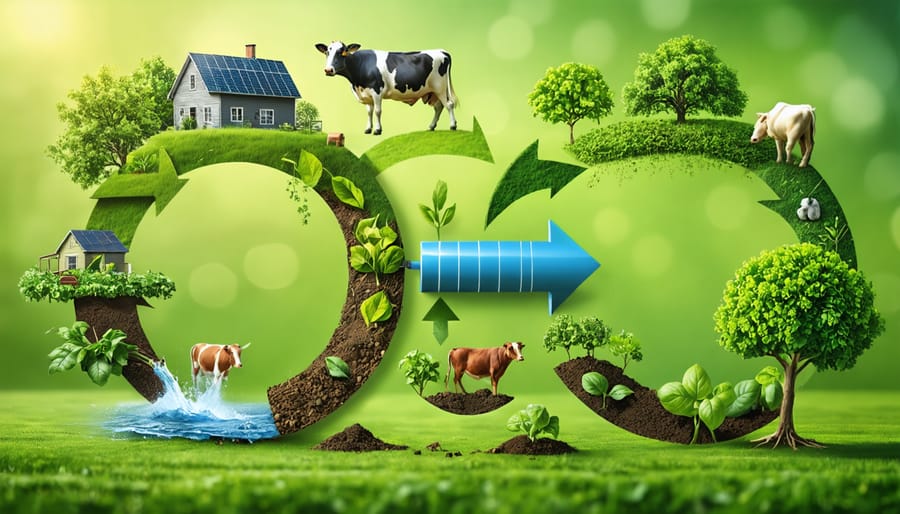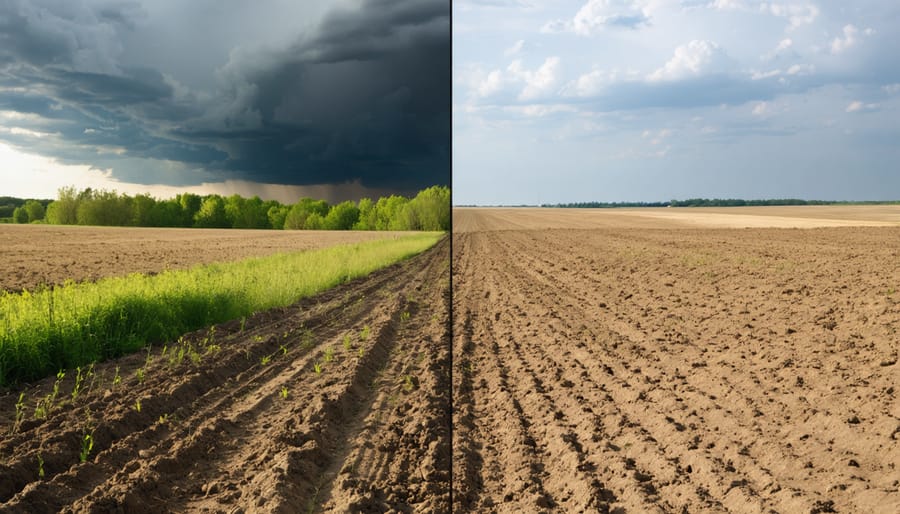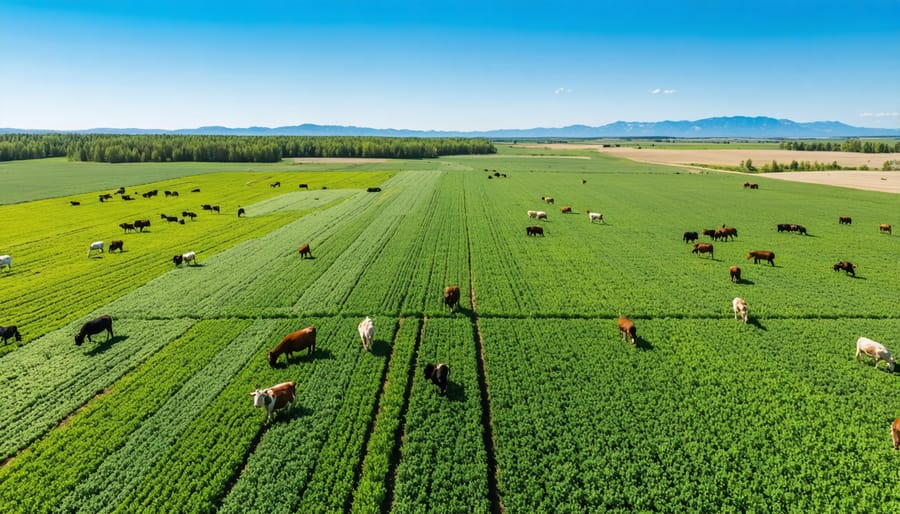Transform conventional farming operations into data-driven powerhouses by implementing GPS-guided tractors, yield mapping systems, and variable rate technologies that boost productivity by 15-30%. Deploy soil moisture sensors and automated irrigation controls across field zones to optimize water usage while maintaining ideal growing conditions for each crop variety. Integrate real-time weather monitoring stations with sustainable agriculture practices to reduce input costs and minimize environmental impact through precise application timing. Monitor crop health using drone-mounted multispectral cameras and satellite imagery, enabling early detection of nutrient deficiencies and pest pressures before yield loss occurs.
These precision farming innovations have revolutionized Alberta’s agricultural landscape, where forward-thinking producers now manage thousands of hectares with unprecedented accuracy. By combining real-time data collection with automated decision-making systems, farmers are achieving consistent yields while reducing chemical inputs by up to 40% and water usage by 25%.
The Building Blocks of Modern Precision Farming
GPS and Mapping Systems
GPS and mapping systems form the backbone of modern precision farming in Canada, allowing farmers to optimize their operations with centimetre-level accuracy. Using satellite technology and real-time kinematic (RTK) positioning, these systems create detailed field maps that track variations in soil conditions, crop health, and terrain across your land.
Many Alberta farmers have found success using GPS auto-steering systems, which reduce overlap in seeding, spraying, and harvesting operations by up to 90%. These systems work alongside field mapping software to create precise boundaries, identify problem areas, and track year-over-year changes in field conditions.
The mapping component generates detailed layers of information, from soil composition to yield data, helping you make informed decisions about input application rates and timing. By combining GPS guidance with mapping tools, you can create variable rate prescriptions for seed, fertilizer, and crop protection products – leading to more efficient use of resources and reduced input costs.
For those just starting out, basic GPS guidance systems can be a practical first step, with the option to add more sophisticated mapping capabilities as your precision farming journey progresses.
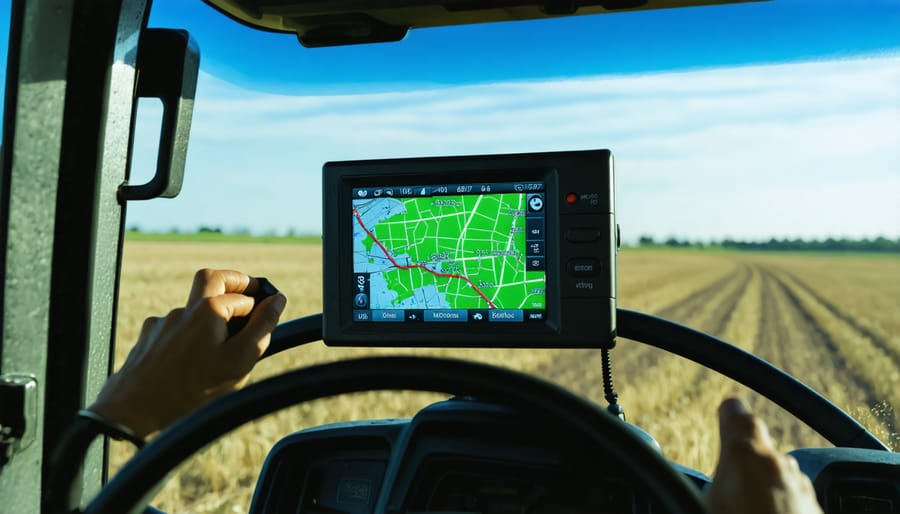
Smart Sensors and IoT Networks
Smart sensors and IoT networks form the backbone of modern precision farming, acting as the eyes and ears of your operation. These systems continuously monitor crucial factors like soil moisture, temperature, and nutrient levels, sending real-time data straight to your smartphone or computer.
Here in Alberta, farmers are increasingly adopting wireless sensor networks that can withstand our challenging climate. These rugged sensors, typically placed every 2-5 hectares depending on field variability, connect through mesh networks to ensure reliable data transmission even in remote areas.
The most common sensors include soil moisture probes that measure water content at different depths, weather stations that track local conditions, and nutrient sensors that monitor nitrogen levels. Many Alberta farmers are finding particular value in frost monitoring sensors, which can alert them to potential crop damage during our unpredictable spring and fall seasons.
What makes these systems truly “smart” is their ability to work together, creating a comprehensive picture of your field conditions. The data collected helps automate irrigation systems, optimize fertilizer application, and predict potential issues before they become problems.
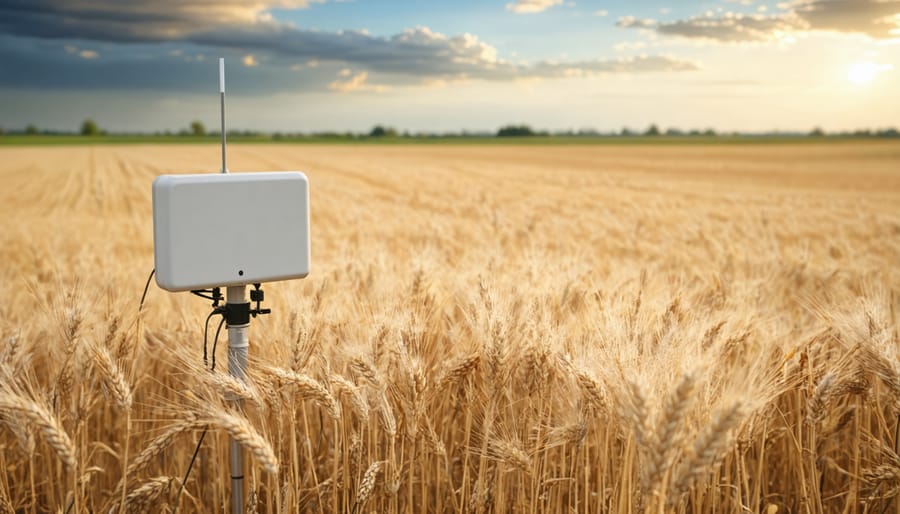
Variable Rate Technology (VRT)
Variable Rate Technology revolutionizes how we apply inputs across our fields by automatically adjusting application rates based on precise field data. Instead of treating entire fields uniformly, VRT systems allow for customized application of fertilizers, seeds, and crop protection products according to specific zones within each field.
Using GPS mapping and detailed soil analysis, VRT equipment can vary inputs in real-time as machinery moves across the field. For example, areas with lower soil fertility receive more fertilizer, while naturally fertile zones receive less, optimizing both cost and environmental impact.
Many Alberta farmers report 10-15% reduction in input costs after implementing VRT systems, while maintaining or improving yields. The technology is particularly valuable for our variable soil conditions, helping manage everything from sandy loam to heavy clay within the same field. Modern VRT systems can integrate with most existing equipment through simple controller upgrades, making it an accessible entry point into precision farming.
Real Results from Alberta Farms
The Johnson Family’s Smart Irrigation Story
For third-generation farmers Bob and Sarah Johnson of Red Deer County, the decision to implement smart irrigation technology on their 800-hectare operation transformed not only their water usage but their entire approach to farming. Like many Alberta farms, the Johnsons faced increasing pressure to conserve water while maintaining crop yields.
“We were using traditional irrigation methods, but the inconsistent rainfall patterns meant we were either over-watering or under-watering different sections of our fields,” explains Bob. In 2020, they invested in a precision irrigation system equipped with soil moisture sensors, weather monitoring stations, and GPS-guided sprinklers.
The results were remarkable. Within the first growing season, the Johnsons reduced their water consumption by 30% while increasing their canola yield by 15%. The system’s soil sensors provide real-time moisture data, allowing for targeted irrigation in specific field zones rather than blanket coverage.
Sarah emphasizes the practical benefits: “The smartphone app lets us adjust irrigation schedules from anywhere. During last summer’s heat wave, we could respond immediately to changing conditions, even while away at our daughter’s soccer tournament.”
The Johnsons’ initial investment of $75,000 was offset by government sustainability grants and water conservation incentives. They project complete system payback within four years through reduced water costs and improved yields. Their success has inspired five neighboring farms to adopt similar systems, creating a local network of precision farming advocates who share data and best practices.
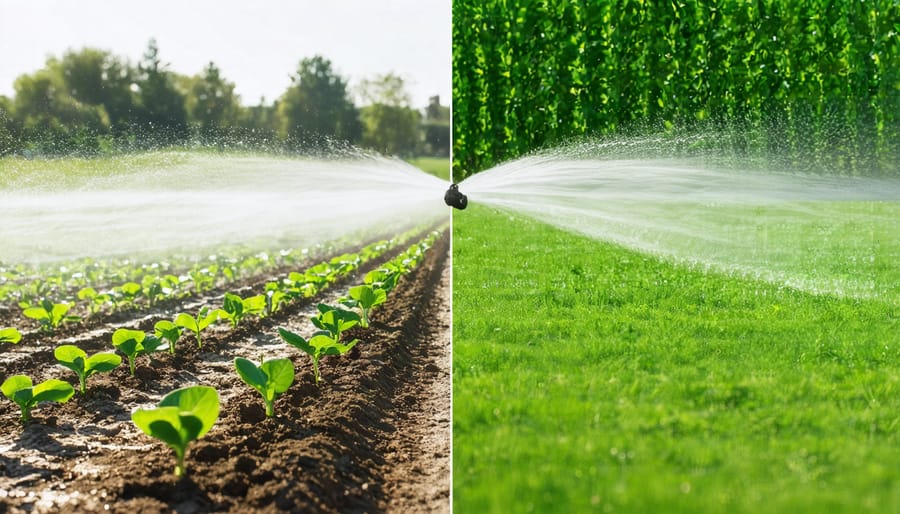
Precision Seeding Success at Prairie View Farm
Located just outside of Red Deer, Alberta, Prairie View Farm has become a shining example of precision seeding success. Fourth-generation farmer Mike Thompson implemented variable-rate seeding technology three years ago, transforming his 2,000-hectare operation’s productivity and sustainability.
Using soil mapping and GPS guidance systems, Thompson’s team now precisely controls seed placement and population rates across their canola and wheat fields. The system adjusts seeding rates based on soil conditions, moisture levels, and historical yield data for each field section.
“We’re seeing up to 15% better emergence rates in challenging areas where we previously struggled,” Thompson explains. “The technology helps us put the right amount of seed exactly where it needs to be.”
The farm’s data shows remarkable improvements since adoption:
– 12% increase in overall crop emergence
– 20% reduction in seed waste
– $45,000 annual savings in seed costs
– More uniform crop development across fields
The initial investment of $75,000 in precision seeding equipment was recovered within two growing seasons through improved yields and reduced input costs. Thompson’s team uses a combination of RTK guidance systems and variable-rate controllers integrated with their existing air seeder.
“The key was starting small and scaling up,” Thompson advises. “We began with one field to test the system, then expanded once we saw the results. The learning curve wasn’t as steep as we expected, especially with support from our local precision ag specialist.”
Prairie View Farm now hosts field days to demonstrate their precision seeding practices to other Alberta farmers, sharing their experience and helping build a community of tech-savvy agricultural innovators.
Getting Started Without Breaking the Bank
Essential First Steps
Starting your precision farming journey doesn’t require an immediate large-scale investment. Begin with these fundamental components that offer the best return on investment for Canadian operations.
A reliable GPS guidance system is your essential first step, helping reduce overlap and improve field efficiency. Most Alberta farmers start with a basic receiver and display unit, which typically costs between $3,000 to $8,000. This investment quickly pays for itself through reduced input costs and improved accuracy.
Soil testing and mapping are crucial baseline measurements. Consider starting with grid soil sampling every 2.5 hectares to understand your field’s variability. Partner with local agronomists who can help interpret results and create detailed nutrient management plans.
Variable rate controllers for your existing equipment are another smart early investment. These systems can be retrofitted to most modern spreaders and sprayers, allowing you to vary application rates based on your soil maps and yield data.
A user-friendly farm management software system helps tie everything together. Look for platforms that offer free trials and good technical support. Many Canadian agricultural equipment dealers offer training sessions during the off-season to help you maximize these tools.
Remember, start small and focus on mastering one system at a time. Many successful precision farmers in Alberta began with just GPS guidance and gradually expanded their technology suite as they became more comfortable with the basics.
Available Grants and Support Programs
Canadian farmers looking to embrace precision farming technologies have access to several valuable funding opportunities and support programs. The Canadian Agricultural Partnership (CAP) offers grants specifically designed to support agricultural technology adoption, with funding available for equipment purchases, training, and implementation costs.
In Alberta, the Environmental Stewardship and Climate Change Producer Program provides up to $100,000 in cost-shared funding for precision agriculture equipment that promotes sustainable farming practices. The Farm Technology Program offers additional support, covering up to 50% of eligible costs for precision farming tools and software.
The Agricultural Clean Technology Program, administered by Agriculture and Agri-Food Canada, provides financial assistance for innovative precision farming solutions that reduce environmental impact. Farmers can access between $50,000 and $2 million for qualifying projects.
Local agricultural societies and producer groups often provide mentorship programs and knowledge-sharing networks. The Alberta Precision Agriculture Association offers workshops, field demonstrations, and peer support to help farmers successfully implement new technologies.
Financial institutions, including Farm Credit Canada and ATB Financial, offer specialized lending programs with competitive rates for precision farming investments. Many equipment manufacturers also provide flexible financing options and technical support packages to help ease the transition to precision farming systems.
Environmental and Economic Benefits
Resource Conservation Metrics
Recent studies across Alberta’s farming operations demonstrate significant resource conservation achievements through precision farming systems. Farms implementing these technologies report water usage reductions of 20-30% through smart irrigation systems that respond to real-time soil moisture data. Advanced fertilizer application systems have shown remarkable efficiency, with farmers reducing nitrogen inputs by 15-25% while maintaining or improving yield rates.
Pesticide application has seen perhaps the most dramatic improvements, with spot-spraying technologies cutting chemical usage by up to 40% compared to conventional blanket application methods. These reductions not only benefit the environment but also contribute to farm sustainability through decreased input costs.
Local data from the 2022 growing season shows that farms using precision systems saved an average of 200,000 litres of water per hectare and reduced fertilizer use by 45 kg/ha. These improvements translate to substantial cost savings, with many operations reporting payback periods of 2-3 years on their precision farming investments. Moreover, the reduction in chemical inputs has led to improved soil health and reduced environmental impact, creating a positive cycle for long-term agricultural sustainability.
Long-term Cost Savings
A detailed ROI analysis conducted across Alberta farms shows that precision farming systems typically pay for themselves within 2-3 growing seasons. While initial costs can range from $15,000 to $50,000, depending on the technology package chosen, the long-term savings are substantial. For example, Alberta grain farmer Mike Thompson reported a 30% reduction in input costs after implementing GPS-guided equipment and variable rate technology on his 2,000-hectare operation.
The economic benefits extend beyond direct input savings. Precision farming systems help reduce fuel consumption by an average of 15% through optimized field operations and reduced overlap. Labour costs typically decrease by 20-25% as automation handles tasks more efficiently. Soil sampling and mapping technologies enable targeted fertilizer application, cutting fertilizer waste by up to 40% while maintaining or improving yields.
Saskatchewan Agricultural Services data shows that farms using precision systems experience an average increase in crop value of $45-65 per hectare annually. When combined with government incentives for sustainable farming practices, the financial advantages make precision farming a sound investment for Canadian agricultural operations.
As we’ve explored throughout this article, precision farming systems represent a transformative approach to agriculture that’s particularly relevant for Canadian farmers. By embracing these technologies, Alberta’s agricultural community has the opportunity to enhance productivity while promoting sustainable practices.
The key takeaways demonstrate that precision farming isn’t just about adopting new technology – it’s about making smarter, data-driven decisions that benefit both your operation and the environment. From variable rate application to yield mapping and automated guidance systems, these tools can significantly improve efficiency and reduce input costs while maximizing yields.
To begin implementing precision farming systems on your operation, start with a thorough assessment of your current practices and identify areas where technology could make the biggest impact. Consider joining local farming networks or reaching out to agricultural extension services for guidance and support. Many successful adopters in our region began with one or two precision technologies before gradually expanding their systems.
Remember that precision farming is an investment in your operation’s future. While the initial costs may seem significant, the long-term benefits – including reduced input waste, improved soil health, and increased yields – make it a worthwhile consideration for forward-thinking farmers.
Take the first step by connecting with local equipment dealers, attending precision farming workshops, or consulting with nearby successful adopters. The transition to precision farming doesn’t have to happen overnight – start small, learn continuously, and scale up as you become more comfortable with the technology.

